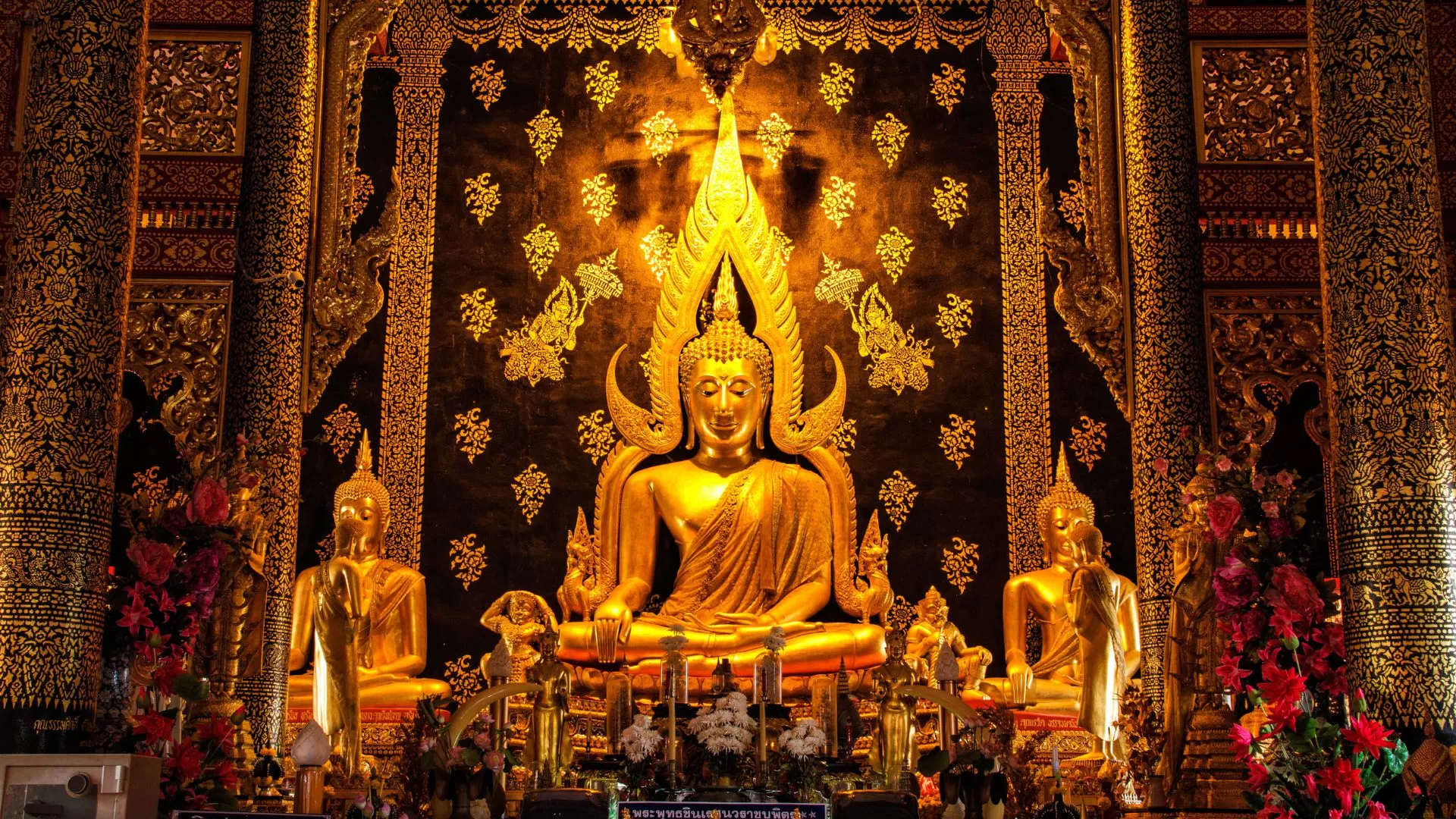- Buddhism and Hinduism: Spiritual Revolutions of the East
- Keywords:
- Key Takeaways:
- Frequently Asked Questions (FAQs):
- What are the primary texts that encapsulate the teachings of Buddhism?
- How did the caste system influence Hindu society and its spiritual practices?
- How do Hinduism and Buddhism view the afterlife?
- What role did royal patronage play in the spread of Buddhism?
- Can one be both a Hindu and a Buddhist?
- How do Hinduism and Buddhism approach the concept of God or gods?
- How have Hinduism and Buddhism influenced eastern philosophy and culture beyond India?
- Were there significant interactions or exchanges between other world religions and Hinduism and Buddhism?
- How have Hinduism and Buddhism adapted and changed in the modern era?
- How do Hinduism and Buddhism view and practice meditation?
- Myth Buster:
- Myth: Hinduism and Buddhism are the same or very similar religions.
- Myth: All Buddhists are vegetarians, like many Hindus.
- Myth: Hinduism is only practiced in India, and Buddhism is an East Asian religion.
- Myth: Reincarnation in Buddhism and Hinduism implies returning as animals or objects.
- Myth: Hindu gods are analogous to Greek or Roman gods.
- Myth: Buddhism rejects all Hindu concepts and teachings.
- Myth: The Buddha is a god in the Hindu pantheon.
- Myth: Hinduism supports the caste system, while Buddhism is entirely egalitarian.
- Myth: All forms of Hinduism and Buddhism involve elaborate rituals and ceremonies.
- Myth: Hinduism is an idolatrous religion, while Buddhism avoids idol worship.
Buddhism and Hinduism: Spiritual Revolutions of the East
In the enchanting realms of the ancient East, where the mountains whispered secrets to the skies and the rivers sang ballads of epochs past, a spiritual renaissance, as profound as the tranquil Himalayas and as diverse as the teeming life of the Ganges, unfolded. Amidst this terrain, where nature and the cosmos danced in harmonious rhythm, Hinduism and Buddhism, two spiritual streams, flowed, nourishing the souls of civilizations and painting histories with the hues of transcendence.
Our tale begins in the resplendent tapestry of Hinduism, a faith not born out of historical revolutions or divine proclamations, but emerging as organically as the banyan tree, with its roots burrowing deep into the cultural soil of ancient India, and its branches weaving the air with tales of gods and mortals, creation and dissolution, dharma and karma. Hinduism wasn’t merely a religion; it was the pulsating rhythm of a civilization’s heartbeat, echoing the cosmic dance of the universe.
In the realm where celestial beings danced in the earthly realms and epics not just narrated stories, but unveiled profound cosmic truths, Hinduism unfolded like a lotus in perpetual bloom. Each petal, inscribed with the tales of deities and demigods, of heroic mortals and mythical creatures, revealed not just religious doctrines but profound, universal truths. The Vedas, Upanishads, epics like Mahabharata and Ramayana—they weren’t mere scriptures, but the soulful verses of a civilization’s existential and spiritual voyage.
Yet, amidst this divine dance of celestial beings and mortal souls, where kingdoms rose and fell and dharma and adharma eternally combated, a prince was born. Siddhartha Gautama, not destined for a throne or a crown, but for a journey as profound as the winding paths of the Himalayas. Amidst the luxuries of palace walls and the celestial prophecies of royal astrologers, the young prince was ensnared not by the allure of power but by the profound enigma of human suffering.
One day and one night, under the tranquil gaze of the Bodhi tree, Siddhartha transcended mortal bounds and earthly illusions. He wasn’t a prince anymore; he was the Buddha, the enlightened one, echoing not royal decrees, but profound, universal truths. Buddhism, like the serene flow of the Ganges, was born.
Now, you would think that Hinduism and Buddhism, each profound and majestic in its own right, would be like two emperors vying for the celestial throne of spiritual sovereignty. But no, in the grand narrative of the ancient East, these two weren’t competitors but companions, not warriors but wanderers on the same profound journey of spiritual discovery.
Buddhism, with its Four Noble Truths and the Eightfold Path, was like the tranquil full moon night, echoing silence, serenity, and the profound enlightenment of the soul. Hinduism, with its myriad deities, epic tales, and cosmic dances, was like the resplendent day, echoing the eternal dance of creation, preservation, and dissolution.
In the shadow of the tranquil Himalayas and along the vibrant banks of the Ganges, these two spiritual streams flowed, not in isolation, but in harmonious confluence. The ancient East wasn’t just marked by kingdoms and empires, wars, and revolutions, but by this serene dance of two spiritual currents, each distinct yet interconnected, each profound yet complementary.
Buddha was born a Hindu, and his teachings, though distinct, were not an abandonment of his roots but a profound continuation. The realms of nirvana and moksha, of dharma and karma, weren’t isolated islands but interconnected continents of a profound spiritual landscape.
Centuries flowed like the perennial rivers, and the spiritual landscapes of the East blossomed. Monasteries and temples, not just architectural marvels but soulful echoes of celestial abodes, adorned the land. Monks and sages, scholars, and seekers—each a wanderer on the profound journey of spiritual discovery—wove the air with chants and meditations, echoing not religious doctrines but universal truths.
And in this profound tale, where the cosmic and earthly, divine and mortal, profound and simple, danced in harmonious rhythm, we, the seekers of narratives and truths, discover not just the historical journey of religions but the soulful ballet of human civilization. In the tranquil embrace of Buddhism and the resplendent dance of Hinduism, we behold the eternal dance of the human spirit, echoing the celestial rhythms of the cosmos, weaving not just histories and cultures but the profound tapestry of human existence.
In the whispers of the ancient winds and the echoes of the perennial rivers, in the silence of the monks and the chants of the priests, in the serene gaze of the Buddha and the cosmic dance of Shiva, we discover a narrative as eternal as the Himalayas, as diverse as the flow of the Ganges—a narrative of spiritual discovery, not just of the ancient East, but of humanity at large. And in this narrative, we are not mere spectators but eternal participants, echoing the profound dance of existence, where each soul is a note in the celestial symphony of the cosmos.
Keywords:
- Hinduism: An ancient religion originating in the Indian subcontinent, characterized by a rich mythology, various deities, rituals, and philosophical concepts like dharma and karma.
- Buddhism: A spiritual tradition based on the teachings of Siddhartha Gautama, the Buddha, focusing on overcoming suffering and attaining enlightenment.
- Siddhartha Gautama: A prince who renounced his royal life, attained enlightenment under the Bodhi tree, and became the Buddha.
- Dharma: A complex and multifaceted term in both Hinduism and Buddhism referring to cosmic law, righteousness, duty, and moral teachings.
- Karma: The law of action and reaction, where every action has consequences; a foundational principle in Hinduism and Buddhism.
- Vedas: The oldest sacred texts of Hinduism, containing hymns, philosophies, rituals, and guidelines for various aspects of life and spirituality.
- Four Noble Truths: Core teachings of Buddhism that diagnose human suffering and propose a pathway to its cessation.
- Eightfold Path: In Buddhism, a set of guidelines for moral and mental development leading to enlightenment.
- Nirvana: The Buddhist concept of liberation from the cycle of birth and death, characterized by the cessation of suffering.
- Moksha: In Hinduism, liberation from the cycle of birth and death, achieved through spiritual knowledge and righteous living.
Key Takeaways:
- Hinduism and Buddhism, two major spiritual paths, originated and evolved in close proximity in ancient India, each influencing the other.
- Hinduism’s rich tapestry of myths, deities, and philosophical concepts provided a spiritual landscape where Buddhism could arise and flourish.
- Buddhism was initiated by Siddhartha Gautama, who transcended his princely life to become the Buddha, imparting teachings of enlightenment.
- Both religions, though distinct, share concepts like dharma and karma, indicative of their intertwined origins and mutual influences.
- The serene, contemplative nature of Buddhism and the vibrant, mythological richness of Hinduism represent complementary facets of the spiritual heritage of the East.
Frequently Asked Questions (FAQs):
What are the primary texts that encapsulate the teachings of Buddhism?
Buddhist teachings are encapsulated in a collection of texts known as the Tripitaka or Pali Canon. These texts contain the sermons of Buddha, monastic rules, and philosophical discourses, offering a comprehensive guide to Buddhist teachings and practices.
How did the caste system influence Hindu society and its spiritual practices?
The caste system organized Hindu society into distinct hierarchical categories, each with assigned roles and duties (dharma). While it facilitated social order, it also led to social inequities and restrictions, influencing access to spiritual and material resources.
How do Hinduism and Buddhism view the afterlife?
Hinduism believes in a cycle of birth and rebirth (samsara) where the soul reincarnates until it attains moksha. Buddhism also acknowledges samsara but aims for nirvana, a state beyond birth and death where suffering ceases.
What role did royal patronage play in the spread of Buddhism?
Royal patronage was crucial in Buddhism’s spread. Emperor Ashoka, after converting to Buddhism, established many stupas and sent missionaries abroad, significantly contributing to Buddhism’s growth and popularity.
Can one be both a Hindu and a Buddhist?
While Hinduism and Buddhism are distinct, there is a historical and philosophical overlap. Individuals might incorporate practices and beliefs from both, though traditional adherence typically involves commitment to one path.
How do Hinduism and Buddhism approach the concept of God or gods?
Hinduism is polytheistic, with numerous gods and goddesses representing various aspects of the divine. Buddhism is non-theistic; it doesn’t focus on God but on the individual’s path to enlightenment.
How have Hinduism and Buddhism influenced eastern philosophy and culture beyond India?
Both religions have profoundly influenced eastern thought, with Buddhism spreading to East and Southeast Asia and Hinduism influencing the Indian subcontinent and places like Bali. They have shaped art, culture, philosophy, and social norms.
Were there significant interactions or exchanges between other world religions and Hinduism and Buddhism?
Yes, interactions with Islam, Christianity, and other Asian spiritual traditions have occurred, leading to cultural and philosophical exchanges, syncretism, and the evolution of beliefs and practices.
How have Hinduism and Buddhism adapted and changed in the modern era?
Both have adapted to contemporary challenges and opportunities, with new movements, interpretations, and practices emerging. They have also spread globally, attracting followers from diverse backgrounds.
How do Hinduism and Buddhism view and practice meditation?
Meditation is central in both. In Hinduism, it’s often associated with yoga and aims for self-realization and union with the divine. In Buddhism, meditation focuses on mindfulness and awareness, leading to enlightenment.
Myth Buster:
Myth: Hinduism and Buddhism are the same or very similar religions.
Reality: They share historical and cultural roots and some concepts, but are distinct religions with unique beliefs, practices, and philosophical frameworks.
Myth: All Buddhists are vegetarians, like many Hindus.
Reality: While non-harm (ahimsa) is a core value, not all Buddhists are vegetarians. Dietary practices vary among different Buddhist communities.
Myth: Hinduism is only practiced in India, and Buddhism is an East Asian religion.
Reality: Hinduism is prevalent in Nepal, Bangladesh, and has global diaspora communities. Buddhism originated in India and spread across Asia and the world.
Myth: Reincarnation in Buddhism and Hinduism implies returning as animals or objects.
Reality: Reincarnation involves the soul’s rebirth into new bodies, not necessarily non-human, influenced by karma and ethical conduct.
Myth: Hindu gods are analogous to Greek or Roman gods.
Reality: While there are multiple deities, Hindu gods are viewed as manifestations of one ultimate reality (Brahman), a concept distinct from polytheistic pantheons.
Myth: Buddhism rejects all Hindu concepts and teachings.
Reality: Buddhism emerged within the Hindu context and shares, refines, or reinterprets many concepts like karma, dharma, and meditation.
Myth: The Buddha is a god in the Hindu pantheon.
Reality: Hindus may respect Buddha as an avatar of Vishnu, but Buddhists view Buddha as an enlightened being, not a god.
Myth: Hinduism supports the caste system, while Buddhism is entirely egalitarian.
Reality: The caste system is a social structure, critiqued within and beyond Hinduism. Buddhism promotes equality, but cultural and social hierarchies exist in Buddhist societies too.
Myth: All forms of Hinduism and Buddhism involve elaborate rituals and ceremonies.
Reality: Practices are diverse. Some emphasize rituals, while others focus on philosophy, ethics, or meditation, reflecting internal diversity.
Myth: Hinduism is an idolatrous religion, while Buddhism avoids idol worship.
Reality: Idol worship in Hinduism involves symbolic representation of the divine. Buddhism also has iconic representations of Buddha and bodhisattvas for veneration, not worship.










0 Comments